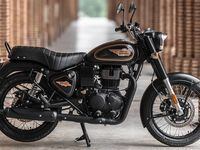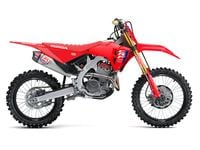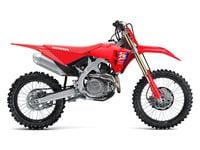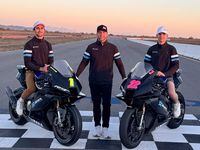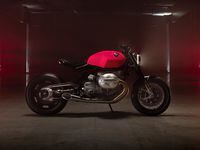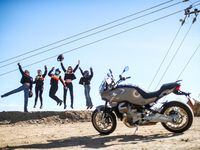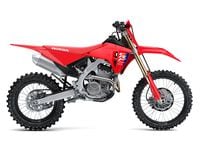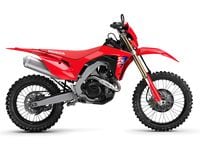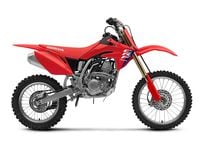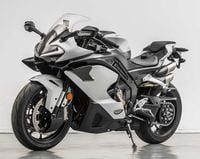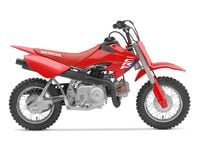When I rode my BMW R 1250 GS press loaner to Penmerryl Farm in Greenville, Virginia, it didn’t have a scratch on it. I have this innate desire to keep a motorcycle pristine—even when I don’t own the thing—but training for the BMW GS Trophy Qualifying means pushing myself beyond my predispositions. That desire to keep the GS looking new has to die. If I want to build my skills, the GS isn’t the only thing that will have to get beaten up a bit.
That much was obvious as soon as I dropped the bike trying to maneuver it through a field of cone courses that looked like they were set up for my toddler’s soccer practice. But this wasn’t child’s play; these impossibly tight courses were examples of what I can expect to encounter at the Trophy Qualifier in October. “This is crazy,” I exclaimed in my helmet. At least I found some comfort knowing I wasn’t alone in my estimation of the situation.
“[The courses are] really tight,” Ben Phaup says. “It’s eye-opening just how tight everything is. If you look at videos, it doesn’t look that hard until you’re on the bike doing it.”
Phaup, who was a member of Team USA at the 2022 BMW International GS Trophy final in Albania, is not prone to exaggeration. The straight-shooting Virginian, a former Marine and father of three, is the kind of guy who likes a challenge—the more strenuous, the better; the more unlikely the odds, the more appealing. Phaup sacrificed a year of evenings and weekends—and much more than that—to train for Trophy Qualifying. In the end, he earned his spot in the finals on his very first attempt.
I wanted to train with Phaup at his newly founded school 241 Moto to see firsthand what it takes to make the Trophy team and to learn some skills of my own. Phaup offers beginner- to advanced-level off-road training, and aspires to make 241 Moto the go-to outfit for Trophy Qualifying training.
“Everything is full-lock turns,” he says of Trophy training. “If you can master that, it’s the biggest thing you can do.”
For those of us who’ve spent most of our riding lives on sportbikes with minimal steering lock, doing a full-lock turn on purpose is a very foreign feeling. When doing a U-turn on a motorcycle, if the bars hit the stop, the bike feels like it’s dropped anchor and the front wheel is going to fold.
For Trophy riding, it’s critical to master the full-lock turn in order to execute many of the maneuvers. Take the classic box turn. The “box,” a 16-foot-by-16-foot square painted on the ground, is the field of play: Without touching the boundaries or dabbing, competitors ride in three dizzying circles in one direction before entering an adjacent square to do the same in the reverse direction. On a 550-pound R 1250 GS, it means turning the handlebars to the stop and using body weight and smooth inputs at the controls to trace an inch-perfect circle through the box. Vision, balance, and line selection are paramount.
Trophy tests are designed to push the limit of riders’ abilities and the GS’ capabilities. While the GS is renowned for its generous steering lock, one still has to know how to take advantage of it. Phaup says that some maneuvers, like a 16 x 16 box turn simply aren’t possible on motorcycles with less steering lock—a lesson he learned the hard way.
When Phaup first learned about the GS Trophy, he mistakenly believed it was a competition for professional riders. Then he heard Shawn Thomas, BMW brand ambassador and owner of Stromoto Training, on the Adventure Rider Radio podcast explaining that it’s an event exclusively for amateur riders and GS owners. When he learned that finalists get an all-expenses-paid trip to an exotic location to compete on a brand-new GS with their name on it, he was immediately inspired.
“In that moment, everything clicked,” Phaup says. “I knew instantly that I was going to be on Team USA—somehow, some way I was going to be there.”
The first obstacle: He didn’t own a GS. Worse, it quickly became apparent that it wasn’t even feasible to practice on the motorcycle he owned.
“I was enjoying my new-to-me KTM 1090 R,” Phaup says, “but its turning radius was so bad compared to the GS. I couldn’t do the drills on it. I loved the 1090 but I was like, ‘I’ve gotta sell it and get a GS,’” he recalls.
As soon as he could, he found an immaculate used 2016 R 1200 GS Adventure.
“It was a garage queen,” he says. “I told the seller, who was a longtime GS owner, what I was going to do with it and he had no clue what the Trophy was. He’d never been off-road, and dismissively said, ‘Some people try to treat these things like dirt bikes…’ I just nodded and laughed. After I left, he looked up the Trophy. I don’t think he would have sold it to me had he known [what I was going to do with the bike].”
And what Phaup does with it is a thing to behold. Climbing impossibly steep embankments, jumping logs, drifting through corners, wheelying for days—generally riding it as if it were a single-cylinder enduro bike. Watching Phaup toss the big GSA around has big entertainment value. He makes it look effortless. It’s humbling.
At Penmerryl, he led me through some of the miles of trails, and I struggled to keep him in sight. Even more than just single-skill maneuvers, like turning tightly, stopping without putting a foot down, or going up or down a steep hill, the really difficult part is combining multiple skills at the same time. To negotiate a steep drop-off/180-degree switchback on the trail required simultaneously combining all of the aforementioned skills. Trail riding on technical terrain like this is really what I want to get good at.
Practicing the cone courses that I’ll see in Trophy Qualifying is an excellent way to build the skills that I need in the wild, but the truth is, I was struggling even in a controlled environment. I’m still not sure what held me back more: my body or my mind. The blisters on my hands burst. I was light-headed from the Virginia heat. I bruised my body and my ego every time I dropped the bike. It stopped being fun.
It’s daunting to come face to face with one’s limitations. Pushing past them and silencing the self-doubt requires serious intentionality. Having committed to competing in the GS Trophy Qualifying means there’s no going back; I have no choice but to face my limitations every time I practice. The extent to which one is willing to submit to failure to find the beginning of success comes down to motivation.
“You have to want it bad enough,” Phaup says. “I’m very competitive by nature. I hate to lose. The more the odds are stacked against me and the more people say something can’t be done, the more it motivates me to prove them wrong. I really locked in and got tunnel vision on training for the Trophy. I poured everything I had into it, which was challenging as a husband and father of young children. There were a lot of evenings when my wife put the kids to bed by herself while I was out trying to get in a little time. In the winter, I was out training in the dark. If the weather was nasty, I was out doing static balance drills or doing full-lock turns in the garage, anything and everything to dial in on slow-speed stuff.”
After returning home, I continued to struggle. I dropped the GS so often the cylinder head covers started to look like I took an angle grinder to them. Even when my failures got to my head, I didn’t accept defeat. I began to realize that success and failure aren’t black and white.
“There’s a lot of gray area inside of good technique,” Phaup says. “The individual rider may have to make small adjustments in that gray area in order to find what works best for them. As an instructor, my goal is to give my students the tools to work with to make them successful. That might look different for different people.”
Before long, I personalized the techniques I learned from training with Phaup, and began to see some progress—in my riding and in my mindset. I’ve grown accustomed to enduring the failures that come along with pushing for improvement.
While my wife is putting the kids to bed, I’ve been practicing: in the rain, in the sweltering heat, in the dark, and when it takes all of my willpower to get off the couch after a long day of looking after the kids. I return home drenched with sweat, with mosquito bites all over me, and a new bruise or two. The GS’ cylinder head covers look worse everyday.
I’m satisfied with my effort, even when I’m not satisfied with my performance. Being willing to fail again and again is a success all its own, and it makes every accomplishment all the more gratifying. I can glimpse that more skilled future self I’d hoped I’d become when I committed to doing this whole thing.
Unlike Phaup, I’m not motivated by a desire to win, but the more time and energy I’ve invested in training, the more I want to keep investing. Motivation is self-perpetuating. It’s a shame I only have a month to go before qualifying because I have a lot left in me to give. It’s even more of a shame that winter will be here before I know it and I’ll have to return the GS to the folks at BMW. I hope they don’t mind a few scratches, because for me, they’re not a sign of failure. They’re a promise of success. Those scratches are sacred; as are my own. I’m beaten up, but not beaten.
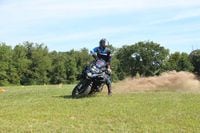
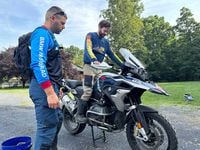
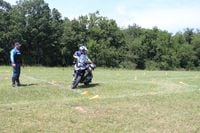
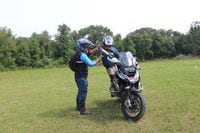
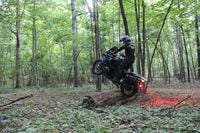
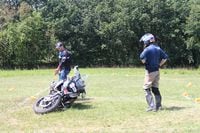
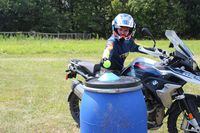
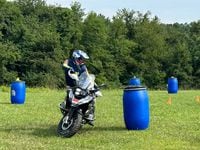
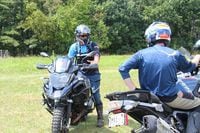

/cloudfront-us-east-1.images.arcpublishing.com/octane/N575KB7BDZDPPJBRLZRG2ANHKI.jpg)
/cloudfront-us-east-1.images.arcpublishing.com/octane/T77HXRXV4NGKDNZODMSEIBRXPE.jpg)
/cloudfront-us-east-1.images.arcpublishing.com/octane/NKMM7V2P3BCSXAV6J56FKK67OU.jpg)
/cloudfront-us-east-1.images.arcpublishing.com/octane/SWQRQV27DNFA7LXGFI7FNFNGOQ.jpg)
/cloudfront-us-east-1.images.arcpublishing.com/octane/GYEXUJBV5JGQLLZNXO7KRVSTEY.jpg)
/cloudfront-us-east-1.images.arcpublishing.com/octane/MCWUSJJVJVG45P7QQG3WOXZR54.jpg)
/cloudfront-us-east-1.images.arcpublishing.com/octane/AJ4EFPH2CRDURDAB5LPEA2V2NE.jpg)
/cloudfront-us-east-1.images.arcpublishing.com/octane/LSDHIL22SZAFFPYLKP5ZXLJSIY.jpg)
/cloudfront-us-east-1.images.arcpublishing.com/octane/SH46HIOX4RELXLXF6AE3SFGH4A.jpg)
/cloudfront-us-east-1.images.arcpublishing.com/octane/JUZ52WFWLJGMNH7PGZNOKP3MUY.jpg)
